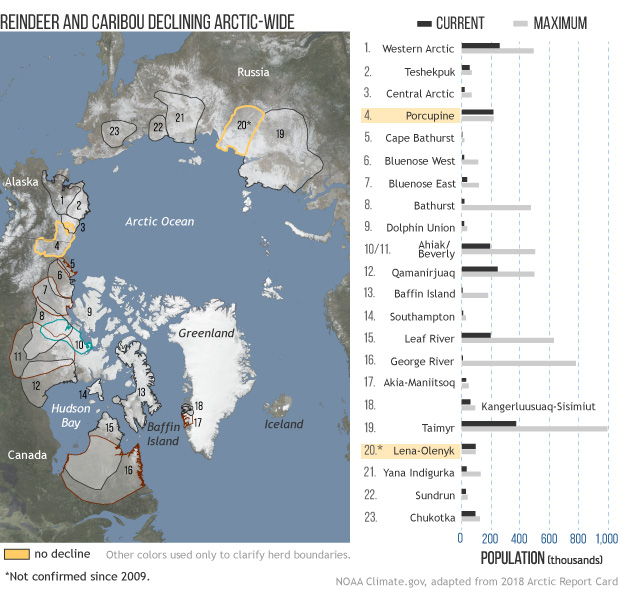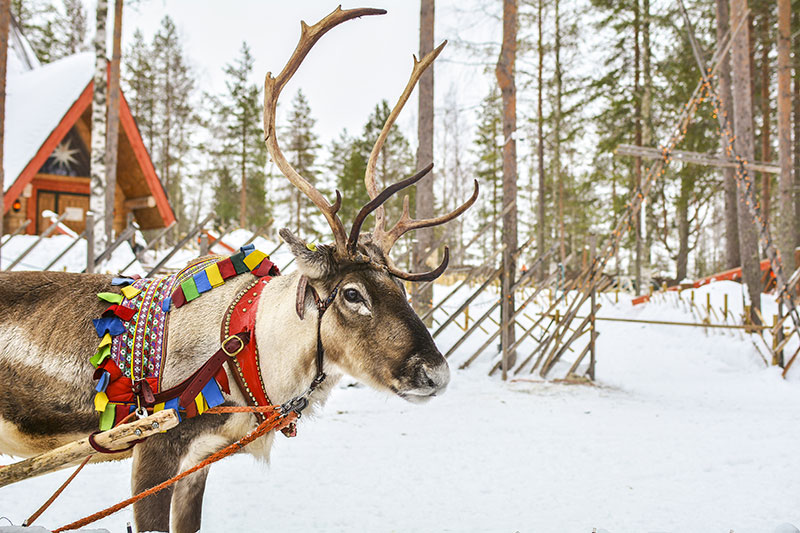
26th December 2018 Reindeer numbers crashed by half in the last two decades In the traditional festive legend, a team of eight reindeer pull the sleigh to help Santa Claus deliver gifts to good children. However, while that quaint image remains among the most cherished of the Christmas period, in the real world an alarming picture has emerged of the animals and their habitat undergoing a serious and rapid decline. A report on climate change in the Arctic, published during the latest American Geophysical Union meeting, concludes that populations of wild reindeer, or caribou, have crashed from around 4.7 million to just 2.1 million in the last two decades. Of the 23 monitored herds, only one is confirmed to be near historic high numbers, according to latest estimates in the 2018 Arctic Report Card. This can be seen on the image below, showing the location of major herds along with a chart of how their current populations (dark grey bars) compare to their historic maximum (light grey bars). Gold highlights indicate the only herds near their historic highs at last count (Lena-Olynyk was last counted in 2009, however, and current estimates are not available). Other colours on the map are only used to clarify overlapping herd boundaries.
It is difficult for scientists to pinpoint the specific causes of an individual herd's decline. However, the overarching factor that links everything is a rapid increase in average temperatures. The Arctic Circle is now warming twice as fast as the rest of the world and some particular "hotspots" – such as Alaska – have experienced even greater rises of 3 to 4°C (5.4 to 7.2 °F) compared to the long-term average. The negative impacts on the Arctic environment include a surge in the number of insects and disease-causing parasites and pathogens, as well as reductions in foraging availability. Heat stress in large animals such as caribou can weaken their ability to overcome illnesses and withstand food shortages. "Warmer climates just mean more bugs in the Arctic," said Professor Howard Epstein, an environmental scientist from the University of Virginia. "It's said that a nice day for people is a lousy day for caribou. If it's warm and not very windy, the insects are oppressive, and these animals spend so much energy either getting the insects off of them or finding places where they can hide from insects." Meanwhile, the warmer climate is leading to a change of vegetation such as the lichen that wild reindeer need to eat. This grows at ground level, but is now being out-competed by other, taller plants. Rain is a major problem, too. Higher temperatures mean more moisture in the atmosphere – a roughly 7% increase in rainfall intensity for each degree of additional warming – which often falls on snowy ground and forms hard, frozen icy layers covering the grazing tundra. In these areas, it becomes difficult or impossible for animals to push their noses through in order to reach their food. Reindeer form part of the Arctic food chain and are important for biodiversity, so without them, other species are impacted. They are vital for human survival, too, with many thousands of people relying on them for the basis of their subsistence economy. Unfortunately, there seems little prospect that the decline in wild reindeer can be reversed anytime soon. The Report Card warns that the region is now entering "uncharted territory" due to climate change.
Comments »
If you enjoyed this article, please consider sharing it:
|








